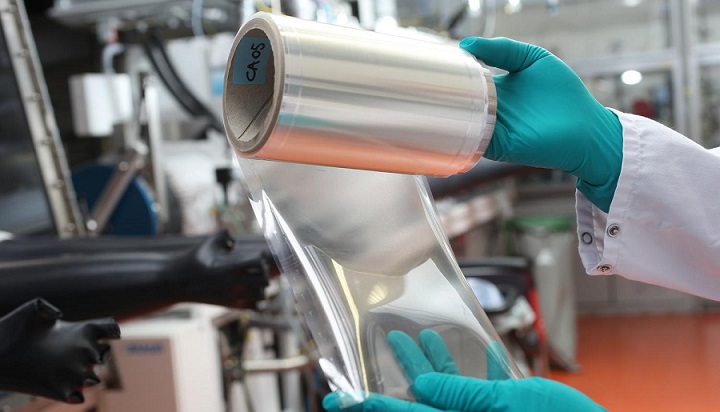In the context of increasing energy demand and lack of natural resources, hydrogen energy technology is regarded as a new hope for energy transition. Hydrogen is not only a key raw material in the chemical industry, but also as a carbon-free fuel used in industry and transportation. "Green hydrogen production" refers to the use of renewable energy to generate hydrogen energy through water electrolysis. This is a green and clean energy production method that can realize the "decarbonization" of energy production. However, compared to the carbon-based energy (such as methane) steam reforming process used in most industrial hydrogen production, the cost of green hydrogen production remains high. Although the cost of using renewable energy to generate electricity is relatively low, the investment cost of the electrolyzer is relatively high.
The ion exchange membrane is the core component of the electrolytic cell, which is very important for electrolysis efficiency and electrolysis reliability.
A few days ago, Evonik successfully developed a new type of anion exchange membrane (AEM), which is expected to break through the existing bottleneck of green hydrogen production. "With this innovative membrane technology, we hope to realize the commercialization of green hydrogen production and make it economical and efficient," said Oliver Conradi, the strategic innovation department of Evonik and responsible for membrane technology innovation.

Defects of existing technology
Alkaline water electrolysis (AEL) is the most widely used process in the existing process. Direct current is applied to the high-concentration potassium hydroxide solution, and the water molecules undergo electrochemical reactions on the electrodes. At the cathode, water molecules decompose into hydrogen ions (H+) and hydroxide ions (OH-) at the cathode. The hydrogen ions combine with electrons from the cathode to form hydrogen gas, and the hydroxide ions reach the anode to produce oxygen and water. In order to ensure the separation of the reaction products and prevent their recombination from causing explosion, a diaphragm is required between the anode and cathode of the electrolytic cell. In order to allow gas to pass through, AEL uses a porous structured diaphragm, which limits the operation of the equipment under pressure. In order to facilitate storage or transportation, the hydrogen produced needs to be compressed, which will generate additional energy consumption. In addition, porous membranes are only suitable for low current density, that is, each square centimeter of the membrane surface can withstand up to 600 mA current.
Another technology is hydrogen production by proton exchange membrane (PEM) electrolysis. In this technology, the proton exchange membrane is not only used to separate the reaction products, but also can make the design of the electrolytic cell more compact, because it is composed of conductive polymer, and the electrodes are located on both sides of the membrane, and the water to be electrolyzed flows through the anode to produce The hydrogen ions from the anode side pass through the proton exchange membrane to the cathode, and generate hydrogen molecules after the cathode reacts. Compared with the AEL system, PEM electrolyzers can not only withstand higher current density, but also deal with greater load fluctuations. Since this technology can be realized under pressure, the subsequent hydrogen compression consumes less energy. Although the PEM system has certain advantages in technology, the investment cost is extremely high. "The PEM reacts under acidic conditions. The materials of the electrolysis system must have excellent corrosion resistance and require catalysts made of platinum, iridium and other precious metals; the electrolysis chamber must be made of titanium or even platinum titanium." Conradi explained.
Evonik's anion exchange membrane: combining the advantages of existing technologies
Compared with AEL or PEM processes, Evonik's anion exchange membrane (AEM) electrolysis combines the advantages of both. The structure of the AEM electrolysis cell is similar to that of the PEM: a membrane made of ion-conducting plastic (also called ionomer) separates the electrodes on both sides of the membrane. The electrode is also made of ionomer and incorporated with catalyst particles. "Unlike PEM, AEM's electrolyzer can rely on nickel-based and other non-precious metal catalysts, thereby effectively reducing material costs." Conradi said. As with the AEL process, the AEM reaction will be carried out in an alkaline environment. Water is electrolyzed at the cathode and hydrogen gas is generated. Other features of AEM electrolysis technology include high current density, high efficiency, and flexibility.
Although initial progress has been made in research and development, the focus of the laboratory is still to optimize the film formulation. "An important factor affecting its efficiency is the contact resistance between the membrane and the electrode. In order to make the resistance as small as possible, we need to establish a good ionic connection between the membrane and the electrode. Therefore, we not only need to continue to optimize the membrane polymer The formula requires custom development of an electrode binder for the membrane.” Conradi said. In addition, the team is further optimizing coating and other processes to achieve mass production of membrane materials.
Evonik's goal is to develop a complete electrolysis system to achieve large-scale hydrogen production from renewable energy. To this end, the company is actively cooperating with other partners. In this research project called CHANNEL, companies and research institutions including the electrolytic cell developer Enapter, the energy company Shell, the German Jülich Research Center, and the Norwegian Institute of Technology and Industry will design based on Evonik’s membrane technology , Build and test the AEM electrolysis system. The related technology verification model is expected to be launched in 2022. In China, this technology has also attracted a lot of interest. At present, Evonik is actively seeking local partners to advance relevant research processes.

